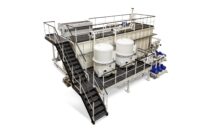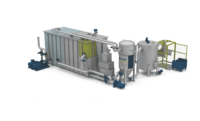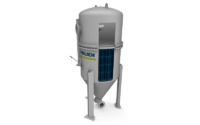precoat filters
Filtration solutions for the optimal treatment of cooling lubricants.


FAUDI precoat filters increase the efficiency and environmental compatibility of your production. Use our filtration solutions for your cooling lubricant treatment, for example, and close production cycles: Our systems ensure that the lubricants are fed back into the process with the desired degree of purity.
Our precoat filters are frequently used in grinding and honing processes, finishing, lapping, eroding, pressing and rolling as well as in ultra-fine filtration. We will be happy to advise you on the best design for your individual application.
We apply high quality standards to all our precoat filtration systems. That is why we focus on a compact and durable design for our filter systems, which ensures a long service life. Equally important: With our precoat filters, you achieve the highest achievable filtrate qualities.
Our precoat filters contribute to closed production cycles that are both more economical and more sustainable. For example, cooling lubricants can be returned to the process with the required degree of purity. Our systems are particularly economical for large volume flows.
Our filter solutions are adapted to different operating conditions and can therefore be used flexibly for a whole range of different processing methods. In addition, each filter type can be customised to your specific application so that you get exactly the solution that your filtration task requires.
Let us advise you now, without any obligation, on the best configuration of our precoat filters for your application.
Our filter type AS works by means of conventional precoat filtration with wet discharge. Sludge treatment and drying takes place by secondary filters.
Sludge treatment and drying takes place directly in the precoat filter on the filter cartridges with subsequent dry filter cake discharge. One advantage is the low space requirement, as no additional secondary sludge treatment is necessary.
Precoat filters type ASG are ideal for cleaning galvanic baths (acid baths), treating saline solutions, electrochemical processing and treating other aggressive media as well as for ultra-fine filtration.

The FAUDI precoat filter consists of a pressure vessel and is divided into a dirty and clean part by an intermediate plate in which the filter elements are installed. The dirty medium is filtered through the filter elements, whereby the flow through the filter elements is from the outside to the inside. However, before the actual filtration of the contaminated medium begins, the filter elements must be precoated with filter aid. During the so-called precoating process, the filter aid is deposited on the filter elements and forms a precoat layer, which ultimately constitutes the filtration fineness. Depending on the filter aid used and the dirt content of the medium to be filtered, filter fineness between 3 and 10 µm can be achieved. After the precoating process, the actual filtration starts automatically. When the maximum filtration time is reached, the filter elements are completely cleaned by an automatic backwash and are available for a new cycle.

The filter pump takes the dissolved mixture of filter aid and clean medium from the precoat tank and applies it to the filter cartridge. The mixture flows through the filter cartridges from the outside to the inside. This precoating process is carried out until a sufficient layer of filter aid has built up on the cartridge.
During filtration, the contaminated medium is taken from the dirt tank after the precoating process, applied to the filter elements and flows through from the outside to the inside. During the filter cycle, the dirt particles accumulate on the precoat layer.
When the maximum differential pressure between the dirty and clean sides of the filter is reached or a preset filtration time is reached, automatic regeneration or backwashing is initiated.
We are your contact for engineering, pipework planning, monitoring and control.